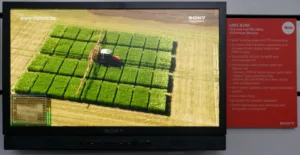Sony was in a very positive mood when it gave its press event just before the show floor opened and on its booth. Sony has been working with the BBC which now can produce in UHD over ip in its new studios that can deal with HDR fully, so production is catching up. Sony supplies a lot of equipment for outside broadcast and has just supplied its 200th OB van with that customer taking its 10th OB van from the company.
Sony believes that the linear TV with the family sitting around the set from 6 pm to 9 pm is declining and broadcasters need to address OTT. Last year, Sony’s big message was a change for the firm from seeing itself as a hardware supplier to becoming about hardware and services. Sony is now re-organising to develop this theme and on the booth the theme in 2017 was ‘Beyond Definition’.
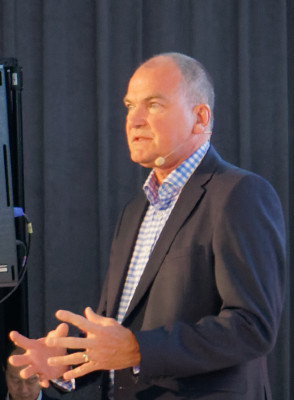 Richard Scott, Sony’s European Head of Media Solutions came on and said that engaging customers starts with engaging stories and great content – Sony sees itself as an enabler of that. Half of stand at IBC was about storytelling and the other half was showing how to enable this.
Richard Scott, Sony’s European Head of Media Solutions came on and said that engaging customers starts with engaging stories and great content – Sony sees itself as an enabler of that. Half of stand at IBC was about storytelling and the other half was showing how to enable this.
Sony Has a Lot of New Cameras
Sony said that, these days, content creators can make stunning images with 4K HDR, HFR, PlayStation VR and at IFA Sony launched the RX0 camera. Although this looks like an action camera for consumers, Sony sees it being used by professionals and said that it can be used to create special multi-camera effects such as ‘bullet time’ and ‘timeslice’.
There were three new UltraHD HDR handycams at the show, the FDR-AX700 (1.0 sensor – 13.2 x 8.8mm), HXR-NX80 and PXW-Z90 which all support both Sony’s S-Log3 format for file-based production in HDR, but also support HLG for ‘grading-free’ HDR capture.
HDR becoming essential for creatives and as well as the HLG ‘instant HDR’ feature, the cameras support super slow motion and fast focus. The top model includes streaming for news capture in professional applications. HDR is supported across all production systems now and UltraHD is the de-facto production standard. The HDC4300 has been a successful camera for Sony and NEP announced a 60 camera purchase and during the show ES Broadcast Hire bought 100 of the cameras.
Scott said that BT Sport was looking to broadcast UltraHD live during the Champions League final in Cardiff in 2017 and chose to use Sony equipment and services. Sony also provided the Hawk-eye technology for goal line decision making. Sony Sports will provide broadcast facilities for the World Cup in 2018.
Nine days before the show, Sony launched the CineAlta Venice cinema camera in the US and IBC saw the first showing of the camera in Europe. It has a full frame sensor with wide colour space and an 8 step ND filter system to help cinematographers to use a range of different lighting. Ed Wild is a cinematographer who has been an Emmy nominee and he came on to talked about testing he has done with the Venice. He had previously used the Sony F65 camera and said that he really liked the ND filters. When using anamorphic lenses, you really can’t change the F stop to manage exposure without changing the look, but the ND filters allow you to keep the same stop in changing exposure conditions.
Then, Scott announced Sony’s first 8K camera, the UHC-8300, which has three separate sensors with 1.25″ sensors and able to record up to 120fps using a new image block. It uses a different EOTF for 8K but can also be used for 4K. A special function of the new camera is to allow a 4K feed (or even a FullHD feed) from a window on the full 8K capture for sports events, allowing directors a lot of choice on viewpoint. For sports, you really don’t want the shallow depth of field that you might want on a movie camera, so the sensors cannot be too big. Sony sees the sensor size on this camera as a good compromise. The camera has a new lens mount.
Services go to the Cloud
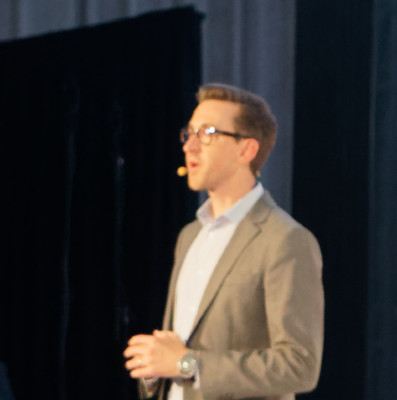 Stuart Almond – Head of Marketing Sony Prof Europe spoke about Advanced Media Operations. On the show floor there were demos of IP live production to London and Sony was collaborating with Suitcase TV over a 1Gb fibre link. This year, in contrast to recent years, there was no data centre on stand and all the Sony workflow demos were cloud-based, using Sony’s Hive system. Sony is also working with IRT on a cloud demonstration and Huawei was also showing a demonstration.
Stuart Almond – Head of Marketing Sony Prof Europe spoke about Advanced Media Operations. On the show floor there were demos of IP live production to London and Sony was collaborating with Suitcase TV over a 1Gb fibre link. This year, in contrast to recent years, there was no data centre on stand and all the Sony workflow demos were cloud-based, using Sony’s Hive system. Sony is also working with IRT on a cloud demonstration and Huawei was also showing a demonstration.
Almond said that TV2/Lorry, rtvOost and IRT are all using Hive in the first year, which is a good result, in his view, for a new prodction platform.
One of the projects that was developed during the last year was that PlayStation VR owners were able to access the champions league final on their VR headsets and VR was being demoed at IBC.
Booth
Later in the show, we talked to staff about the RX0 camera and its use in special effects. Sony has developed the very small ethernet controller that can be used to remotely control the camera to allow the production of special effects such as the ‘bullet time’ and ‘timeslice’ that it talked about.
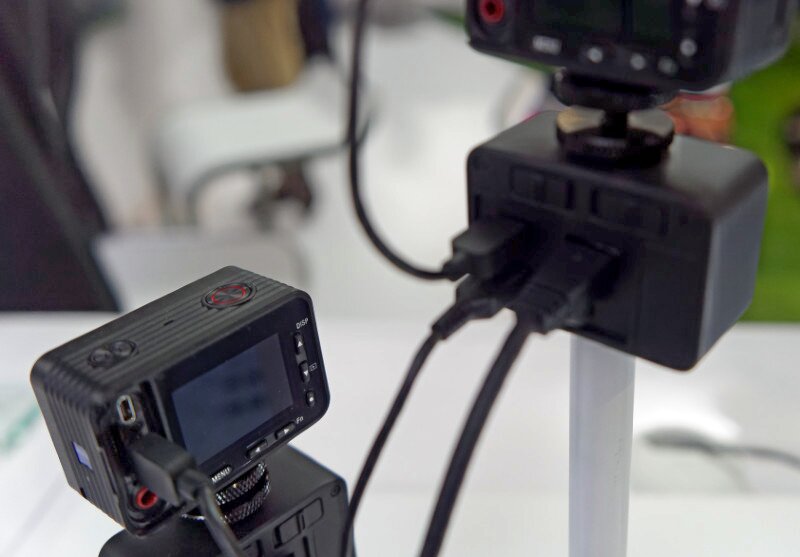 Sony’s RX0 will have a special processor to allow remote control. Image:Meko
Sony’s RX0 will have a special processor to allow remote control. Image:Meko
There were some new broadcast monitors at the show, although in some cases, the change was just in the firmware. The PVM-A170 v2 is a new version of the 16.5″ FullHD OLED and has a number of new features including a sync-free side by side mode, a false colour mode using side by side and an improved flexible area marker for checking, especially, skin tones. The PVM-A250 (24.5″ FullHD OLED) has also been updated to V2.
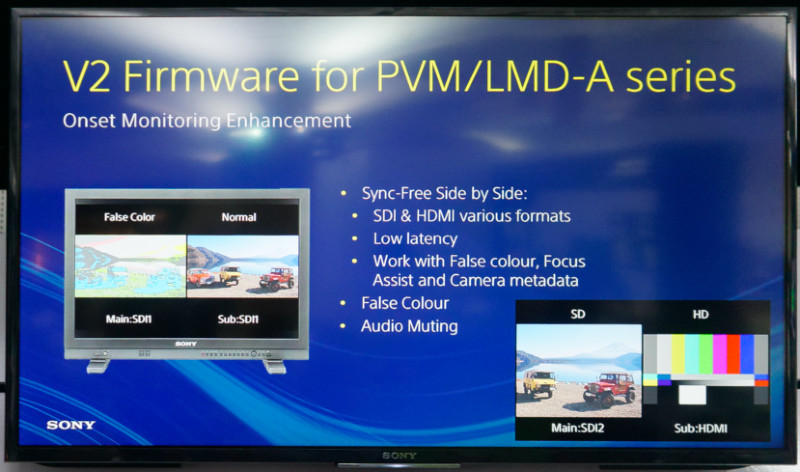 Sony has updated its firmware to add new side-by-side modes. Image:Meko
Sony has updated its firmware to add new side-by-side modes. Image:Meko
The LMD-B240 model is a new IPS LCD monitor with FullHD resolution and with a common interface with the rest of the PVM-A series, but where the full OLED performance is not needed. Features include twin HD/SDI SDI and HDMI as well as a composite I/O. The monitor has a lot of features including a vectorscope and low latency. It can run on DC power
Sony introduced a new FullHD LCD monitor. Image:Meko
Sony has a new 16.5″ FullHD OLED monitor with FullHD resolution and is available with an optional HDR licence that can give support for S-Log3, S-Log3 Live, PQ and HLG. This was the first showing at IBC, but the monitor was released at NAB. (Monitor Round up from NAB).
One of the topics that we spoke to Sony about at the show was peak brightness. As is widely known, OLED monitors such as the firm’s broadcast monitors have great black levels, but the peak white drops back as more and more of the display is white. In the talk by the BBC about HLG, there was an interesting discussion about the level of diffuse white. The BBC said that the diffuse white level is set at 75% of peak white (to allow 2.5 stops of headroom). When you calculate this value based on a peak brightness of 1,000 cd/m², 75% is around 350 cd/m². We asked Sony how much of the screen could be diffuse white to meet this requirement and we heard that it is around 30% to 40% of the screen before the ABL kicks in to adjust the brightness down. This is approximate and depends on the age of the panel and what else is on the display.
Analyst Comment
Sony had its CrystalLED display on the front of the booth, as before, and there was permanently a group of viewers watching the very good content that was being shown. (BR)

